IN THIS SERIES, we showcase armies used by your humble Jungle Guides. By detailing how the army was collected, how the background and color schemes were developed, and how the army is used on the battlefield, we hope that this series will provide inspiration for those interested in collecting similar armies.
Battle, endless battle, on a thousand, thousand worlds, for a thousand, thousand years. Millions fought, millions died—were they memories, or dreams? The captain had slept for so long that he no longer knew.
At this moment, he recalled—imagined?—with exacting detail how he and his soldiers had blasted through the Syryllian’s lines, gunning down the gelatinous amphibians as they ran. He remembered— dreamed?— how the loathsome, pulsating body of the Syryllian DeoRex had literally evaporated under the repeated blows of the captain’s powered combat staff. Even now, so many years later, the captain felt a surge of joy and pride in his victory, just one of a thousand, thousand.
Suddenly, the captain was roused to consciousness by a rich, sonorous voice, one he knew and loved. “Awaken, sweet slave,” the voice said.
The captain looked around. Light—a burning white light—had come to the sealed chamber where he had stood, immobile and inert, for so long.
“It is good to see you again,” the voice said, as the light dimmed and coalesced into a robed figure who sat in a throne atop a dais at the end of the chamber.
The captain raised his staff and took two steps forward. “Remove yourself from the throne of my master,” he growled, his voice little more than a harsh buzz.
“You remember the ancient traditions. Good. Indeed, I am your master.”
“Crystalord is my master,” the captain replied. “You are not him.”
“But I am,” the figure said. It stood, and a golden aura flared around it as it transformed into a faceless humanoid made of dazzling, transparent crystal facets. “This is the form I took when you first swore allegiance to me, and Crystalord was the name I used then.”
“As you command,” the captain said, laying down his staff and kowtowing on the stone floor.
“Rise, my slave,” the figure said. “Many names I have used, and many guises have I worn. Some call me the Jackal God. Others call me the Deceiver. Right here and now, I call myself Yblis.” The crystal figure morphed again into the robed figure. “Now, attend,” it said.
An image appeared in the air nearby. A red-haired female human warrior in black and white tiger-striped armor fought hand-to-hand with a skeletal figure shod in bronze. “I need a new commander for one of my armies. Lord Thoth failed me in in a crucial battle, and destruction has been his just reward,” Yblis said.
The image vanished. “Much time has passed since you served me last, yet I have not forgotten your skill or devotion. I wish you to take Thoth’s place. You will do that for me, won’t you?”
The captain held out his hand above his staff, which still lay on the floor. The staff flickered, vanished, then re-appeared in his grasp. “Yblis is my master,” he said.
“Excellent,” the figure replied. “The name you used when last you served me has been forgotten, even by me,” it chuckled. “In addition to granting you new powers and new warriors, I shall also grant you a new form and a new name. Overlord Lucifer I shall call you, the Bearer of Light—my light.”
Lucifer felt no pain, of course, as Yblis raised his hand and a burst of light sprang from it, temporarily overwhelming his photoreceptors. When they resumed transmitting images, he was mildly surprised to find himself simultaneously viewing Yblis from two different vantage points, each a few feet from the other.
He turned and saw himself: one version stood and held his ancient combat staff; the other wielded a powered warscythe and floated in the air, his legs replaced with an anti-grav platform. Lucifer thought to reach out, and both versions moved their arms forward. He thought to look back at his master, and both heads swiveled. Though he was still of one mind, he now had two bodies to carry out Yblis’ will.
“There is a new force in the universe,” Yblis said. “It calls itself ‘Man.’ I want it destroyed. Exterminated. You will do that for me, won’t you?”
“As you command,” both Lucifers replied.
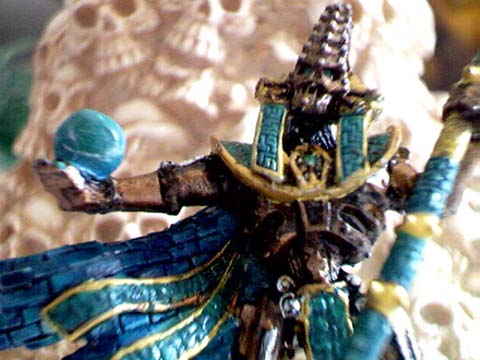
Introduction
Long-time Jungle visitors may recall that in 2003, my friend Patrick Eibel built and painted a Warhammer 40K Necron army. After using the army for several months, Pat decided that he didn’t care for them, and put it up for sale.

I was never a big Necron fan, but it seemed a shame to see such a nicely-done army go. So, I bought it from Pat and set to work on making it my own.
Modeling and Painting
Pat built and painted almost all of the figures, spray-painting them black, then drybrushing them in a brass color. He painted the guns in metallic tones of steel or bronze. Because Pat didn’t like how the clear plastic tube pieces for the guns looked, he went over them with teal. He based the ‘bots with sand flock, painted in typical “desert” style.
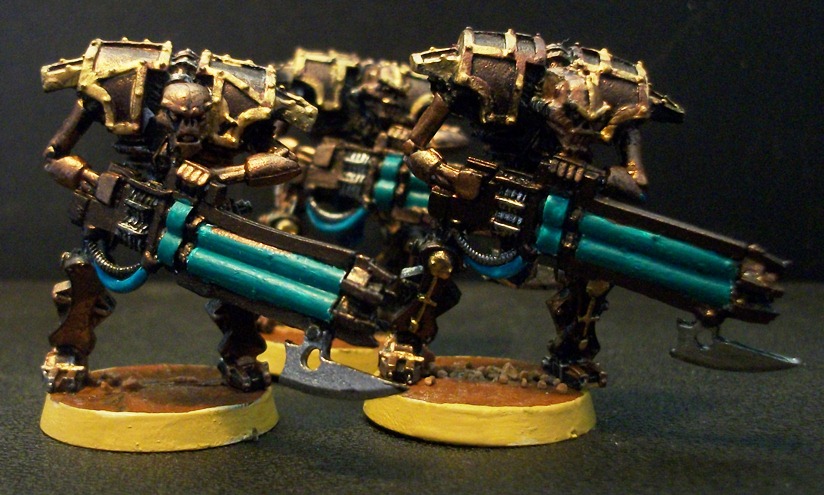
Pat’s original army included Flayed Ones and a Monolith, but after running (and losing) a few games, I ditched both of those units. For a while, I also ran a proxied model as the Deceiver, before eventually getting rid of that.
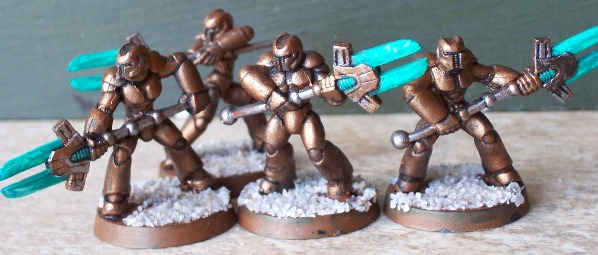
I also added a few models, starting with the miniatures above, which I had in my bitz box. They’re from the VOID 1.1 game, and started off as Pariahs before I decided, in later editions, to treat them as Triarch Praetorians, and then as Guardians under the Grimdark Future rules I currently use (more about that here).
Rather than dish out what was at the time $15 each (and has gone up to $35 each, as of April 2023) for the five Crypteks I wanted, I spent $33 to buy a box of Immortals/ Deathmarks, and made my own, below, using bits from each type. To make each Cryptek’s weapon, I used most of a tesla carbine with the barrel of a synaptic disintegrator. Under the Grimdark Future rules, I count these as Eternals, the GF version of Immortals.
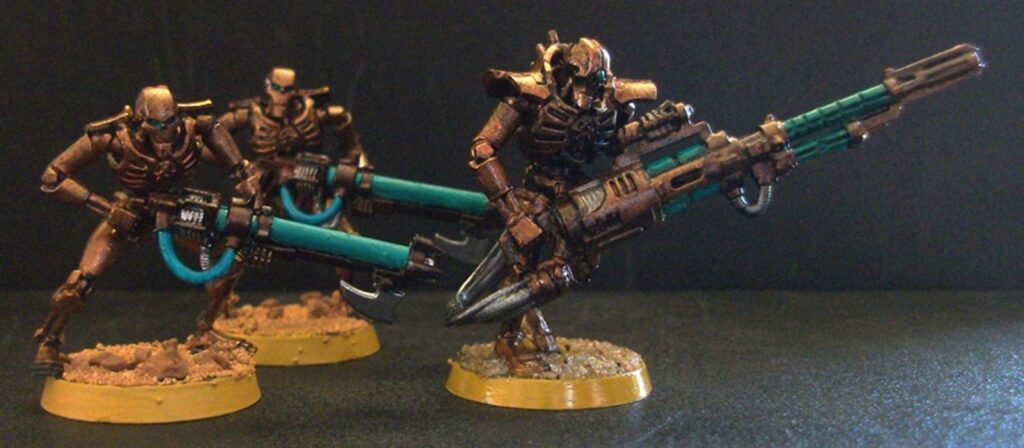
In December 2011, when I was looking for models to use as Night Scythes, Games Workshop didn’t have any, so I drew on the inspiration for my army’s background (see below) and found some 1978 Cylon Raider toys on eBay.
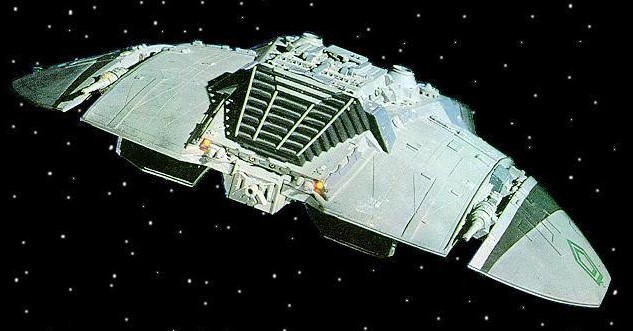
Why use these toys? First, I’ve always liked the looks of the Raiders from the original Battlestar Galactica TV series. Second, they were relatively inexpensive: one cost me $10, the other $20; even with shipping and handling, my “Scythes” were a lot cheaper than what GW would want.* Third, there were quite a few to be found, even after almost 35 years since they had been manufactured.
*As of April 2023, Necron Night Scythes from Games Workshop retail for $70 each. Oof!
Some gamers might sneer at turning “toys” into 40K units, as if none of them are playing a game of “toy” soldiers. But hey, that’s all right by me: they can keep paying more–much more, in most cases–and putting in more effort. Me, I have better uses for my money and time.
I peeled off the stickers that came on the Raiders, glued their wings shut (they had been able to pop open to fire “missiles”), and primed them black. To coordinate them with the rest of my army, I painted most of each bronze, with some parts brass. The GW Jade Green that Pat had used for accents years before was no longer available, but a found a comparable shade–Emerald–from Vallejo.
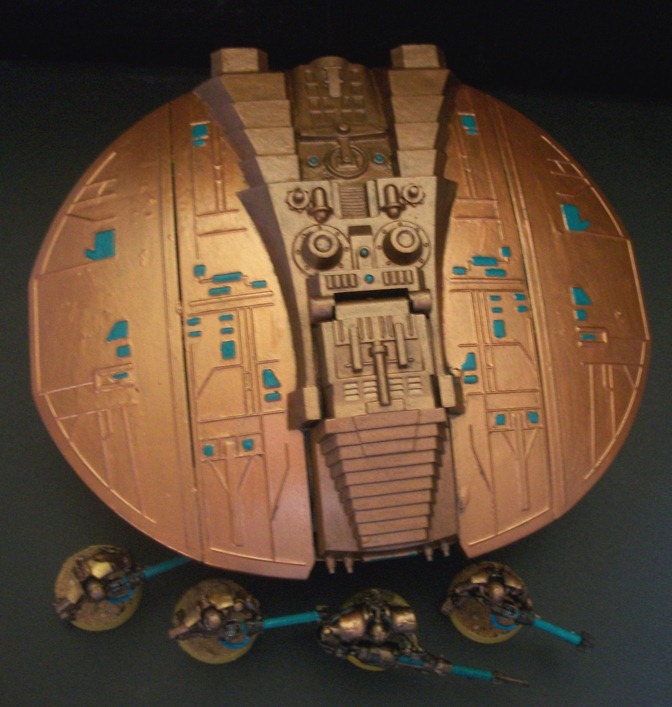
By happy accident, each Raider has a screw right in the exact middle of the toy’s underside; I took out the screw and was pleased to find that the toy didn’t fall apart, which makes me wonder what the screw was for in the first place. The spindle of a standard GW flying base fit perfectly in the hole for the screw, and the toy balanced fine on top of the flying stand.

However, the standard GW 33 mm flying base isn’t nearly tall enough (as you can see from the photos above) to allow Necrons to embark and disembark from the access point underneath the model, so I got some taller flying stands.
Shortly after I had found the Raider toys on eBay, I visited a hobby train shop near my home and found well over a dozen Battlestar Galactica models. Included in the treasure horde were Raiders from the old and new shows, at $25 each. I scooped up several kits.
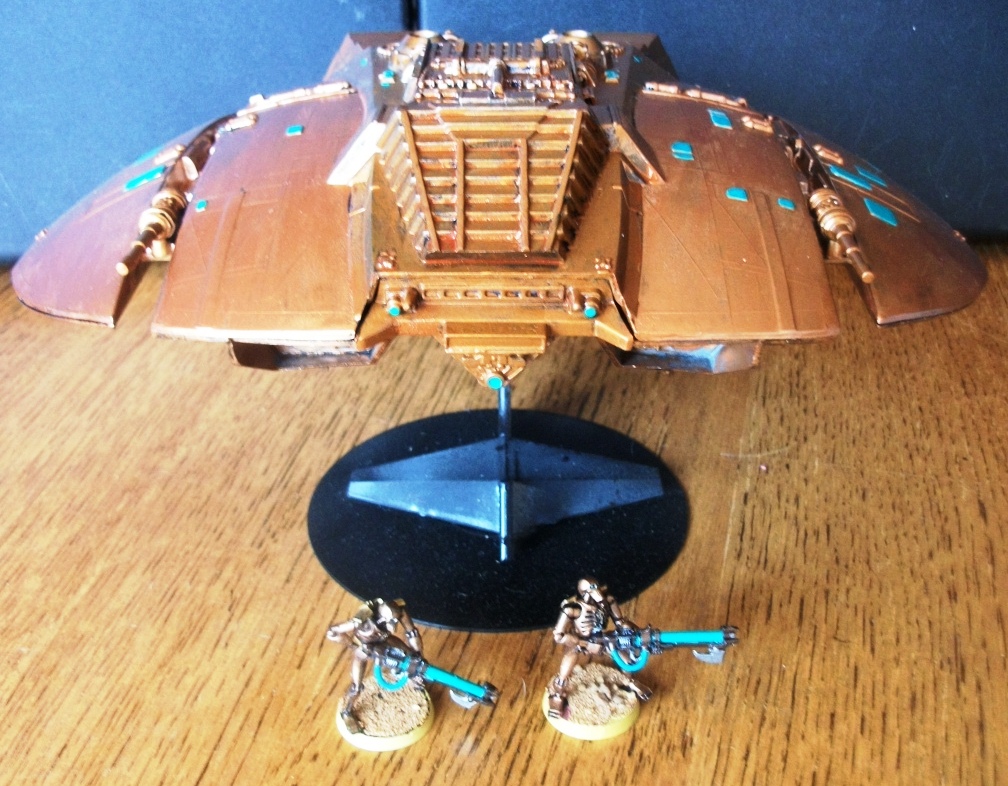
The Raider models are at least twice as big as the toy versions, so to explain that, I say that they’re used by the units of Immortals/ Eternals I have. Not that their squads are larger than the Warriors (they aren’t), but just because Immortals/ Eternals are supposed to be “exalted” than scrub Warriors. Hence, they get the bigger, more luxurious rides.
I also have two of the Raider models from the 2004-2009 TV series (the one you younger gamers are probably more familiar with). I count these as Doom Scythes (or “Doom Fighters,” as GF calls them).
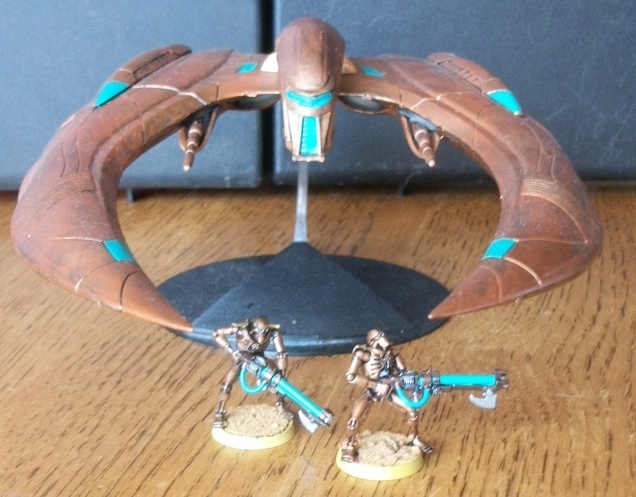
Background
In addition to the Cylon Raider models and some of the subtler painting elements, the army is further distinguished from similar collections by its background, or “fluff.” I’ll get into that in a moment, but first, a short digression.
The first Codex: Necrons, published in 2002, portrayed the ‘bots as mindless automatons who were slaves to the C’Tan. In later versions, Games Workshop revamped the Necrons’ backstory, saying that they had freed themselves from the C’Tan, and that certain individuals had more personality.
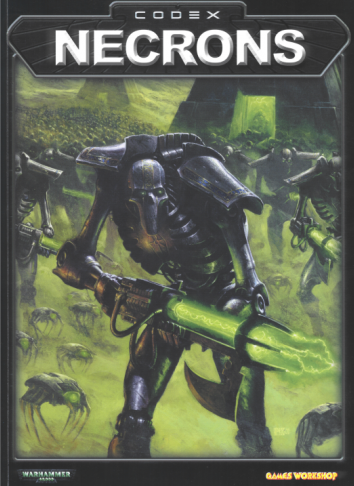
I much prefer the original take on Necrons, with the lack of individuality, and the Lovecraftian gods. The current approach to Necrons makes them too much like Eldar, IMHO:
- Ancient race pre-dating mankind? Check.
- Extremely intelligent, arrogant, and fond of pithy quotes deriding their enemies? Check.
- Lost a galaxy-spanning empire and wish to reclaim it? Check.
- Use nigh-magical technology far more advanced than other races? Check.
There’s nothing unique or interesting in the current characterization of the Necrons, and it suffers greatly compared to the previous vision of them as silent, emotionless drones that exist only to kill (“It’s what they do. It’s all they do,” Reese would have said) in service to their dark masters.

I’m all for injecting some character and personality into the Necrons, but not at the expense of making them more human and less scary, with their idiosyncrasies and snarky comments. You’re not supposed to be able to relate to them: they’re freaking space skeletons! Games Workshop has done to Necrons what Twilight did to vampires: take something terrifying and make it ridiculous.
Okay, let me climb down off my soapbox. In writing up the background material (or “fluff”) for my Necrons, I took most of my inspiration from Battlestar Galactica, which I had watched as a kid. BG concerned itself with a group of space-faring humans searching to find planet Earth, while being pursued by a race of robots, the Cylons.
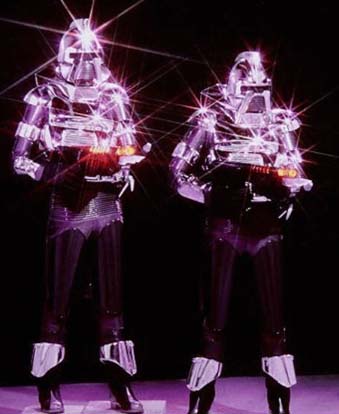
Cylons spoke in buzzing voices, were lousy shots (of course), and wore bulky armor. But they always had the advantage in numbers and were relentlessly bent on “the annihilation of the life form known as Man.”
(Shortly after I decided to use Galactica, I learned about the new, darker series: while I sorta liked the first few episodes I saw, I really didn’t get into it, and thus, didn’t borrow anything from that version)
Here are some specific elements I took from the original series:
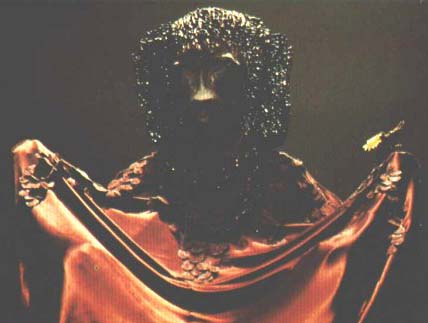
Yblis The Deceiver. In BG, the Cylons served a shadowy, robed figure they called “Imperious Leader.” Viewers never got a good look at Imperious Leader, but he didn’t seem to be a robot. Nor did he sound like one: the British actor Patrick Macnee (most famous for his role in TV’s The Avengers) provided his voice.
In two episodes, Macnee also played Count Iblis, a miracle worker who promised to save the human protagonists from the Cylons if they swore allegiance to him. One character pointed out that Iblis and Imperious Leader had the same voice, but the connection was never explained. Iblis was eventually revealed as a demonic entity in human guise.
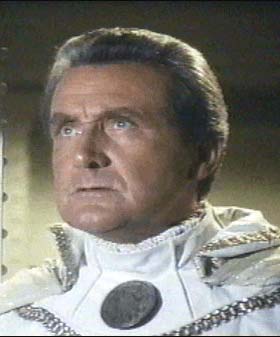
The characters of Imperious Leader and Count Iblis inspired me to choose The Deceiver, under one of his many names, as the ultimate leader of my Necrons. “Yblis” is a combination of the two BG villains: a satanic figure bent on destroying humankind through his mechanical minions. The name “Yblis,” by the way, is pronounced “EE-blee” (the “s” is silent).
In more recent versions of Codex: Necrons, the C’Tan were overthrown by the Toasters, who now sometimes use “Shards” of their former masters’ divine essences in battle. Whatever. My army still serves The Deceiver, meaning that either the story of the C’Tan’s downfall isn’t true, or that somehow a “shard” of the Jackal God has managed to trick an army of Necrons into believing that they are still his to command.
Lucifer. Though the Necrontyr long ago submitted themselves to become machines, the Lords—presumably the strongest-willed of the Necrons—kept some aspects from their mortal lives. Hence, in the fictional piece that begins this article, I have the Necron who becomes Lucifer recall (or imagine?) past battles and victories.
Rather than create separate characters to control my armies, I thought it would be more in keeping with the robotic theme to have The Deceiver create multiple versions of the same Lord and have them share their programming. Thus, Lucifer, a former captain in the armies of “Crystalord” (The Deceiver in another guise), appears as Version 1.1 (an Overlord) and as Version 1.2 (a Destroyer Lord). One mind, one personality, two bodies.

Lucifer takes his name from a more intelligent, more articulate, more human-appearing Cylon (above) from the original Battlestar Galactica series. “Lucifer” is a Latin word meaning “bringer or bearer of light” (and is, like “Iblis,” another name for the Devil).
Centurions. As I mentioned earlier, the rest of the army (from a “story” perspective) is a collection of automatons devoid of personality. Carrying further my inspirations from Battlestar Galactica, I imagine that my Necrons talk, albeit in buzzing, distorted tones unpleasant to the human ear. Being unemotional and not innovative thinkers, they speak only to relay information to Lucifer (“The humans are massed on the southern hill”), or to acknowledge orders (“As you command!”). This is not to say that my Necrons are stupid, just that they don’t stand around reciting soliloquies. One shouldn’t expect witty dialogue from Necrons, anyway.
Thus, I haven’t made up other characters, or given the army’s vehicles names, or anything like that. But because I wanted the force to have an identity (and not just be “my Necrons”), I needed a name for them. I call them “Yblis’ Centurions,” using the name of the Cylon foot soldiers from the original series. Yes I know, “centurion” means a leader of soldiers, not the common infantryman. Don’t blame me, blame the original show’s writers.
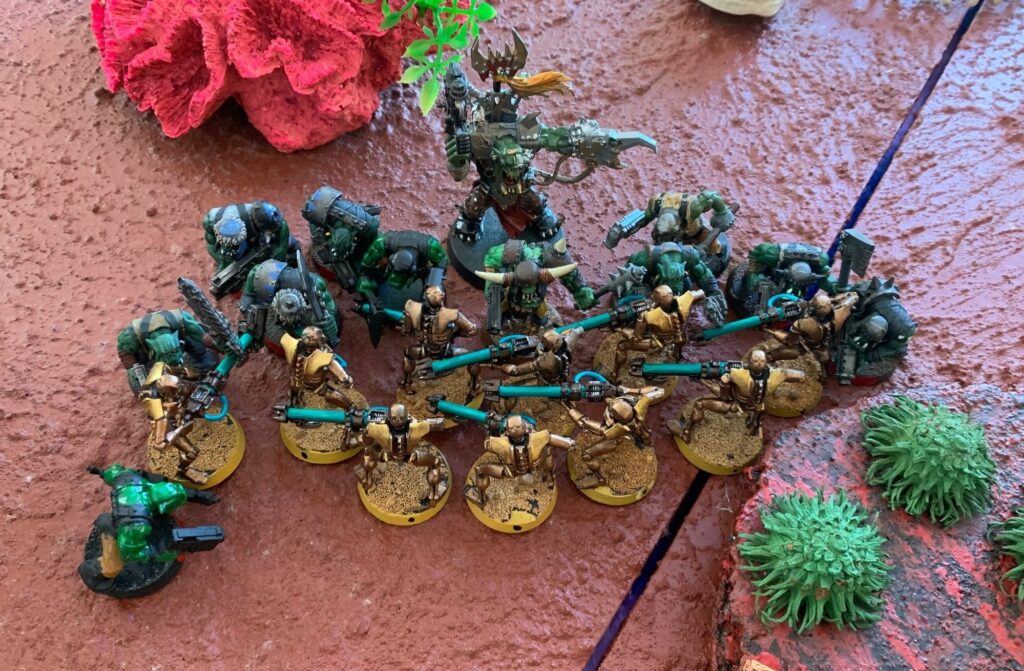
Waging War
Pat never had much success with the army–he called it “cursed”–and for quite a while, I didn’t win many games with it, either. As a 40K army, their tabletop capabilities lay in the middle ground between Space Marines and T’au: they weren’t as tough as the former, and they didn’t have the long-range firepower of the latter. Based on that premise, and using what I had available, I devoted most of my army’s resources to shooting the bejesus out of opponents before they got in assault range.
The army got a significant power boost with the introduction of Night Scythes and Doom Scythes. I have seven of these models in my collection, and when I used them in 40K games, they were backbreakers. Right away, my Necrons went from being chumps to champs.
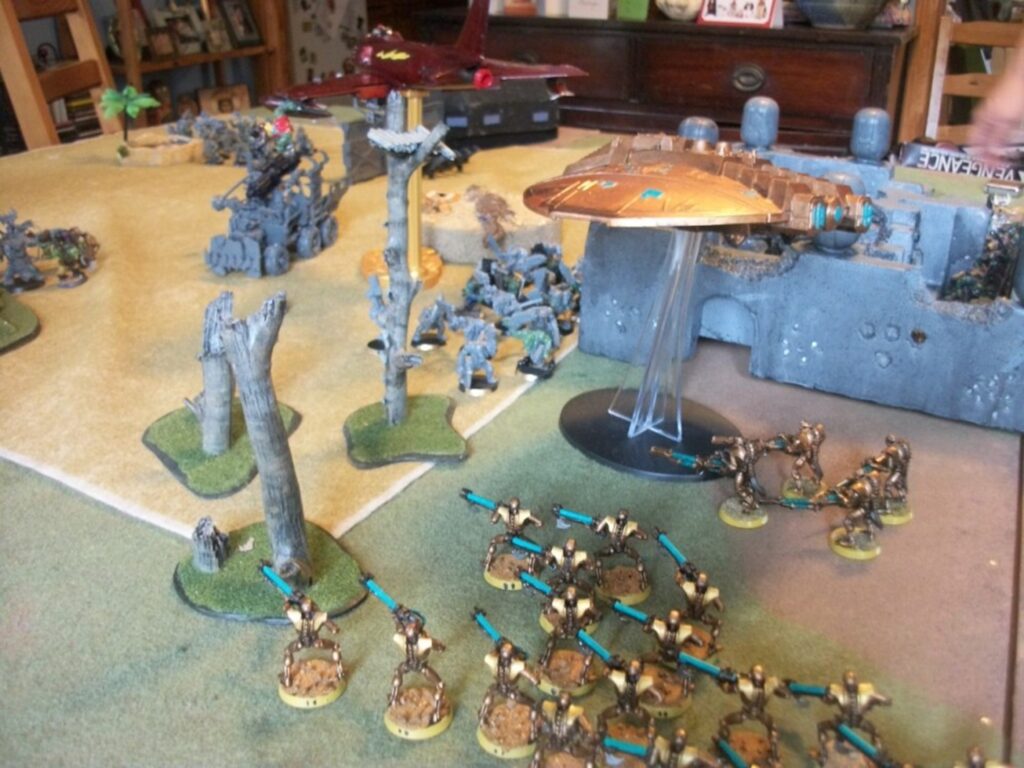
I gave up 40K when I finally got sick of the rules bloat and repeated expense, and switched to Grimdark Future, converting my “Necrons” to “Robot Legions.” Currently, I have three lists of about 3,000 points each, which together use all my models (some units appear in more than one list).
Warriors are mostly what I have (60 total), so one list is all about them, backed by some Immortals/ Eternals. Guardians (the GF version of Lychguard) with jet packs provide mobility and excellent close-combat capability.
This first list represents your typical Necron army, with lots of infantry tramping slowly but inexorably towards the enemy. It’s nothing out of the ordinary, but it is the most “opponent-friendly” of my lists, good for using against people who aren’t familiar with Necrons/ Robot Legions.

Another list features Lokhust Destroyers and Heavy Destroyer models (GF calls them “Annihilators” and “Heavy Annihilators”). It has a bit more mobility and hits harder than the first list, and is, IMHO, more challenging.
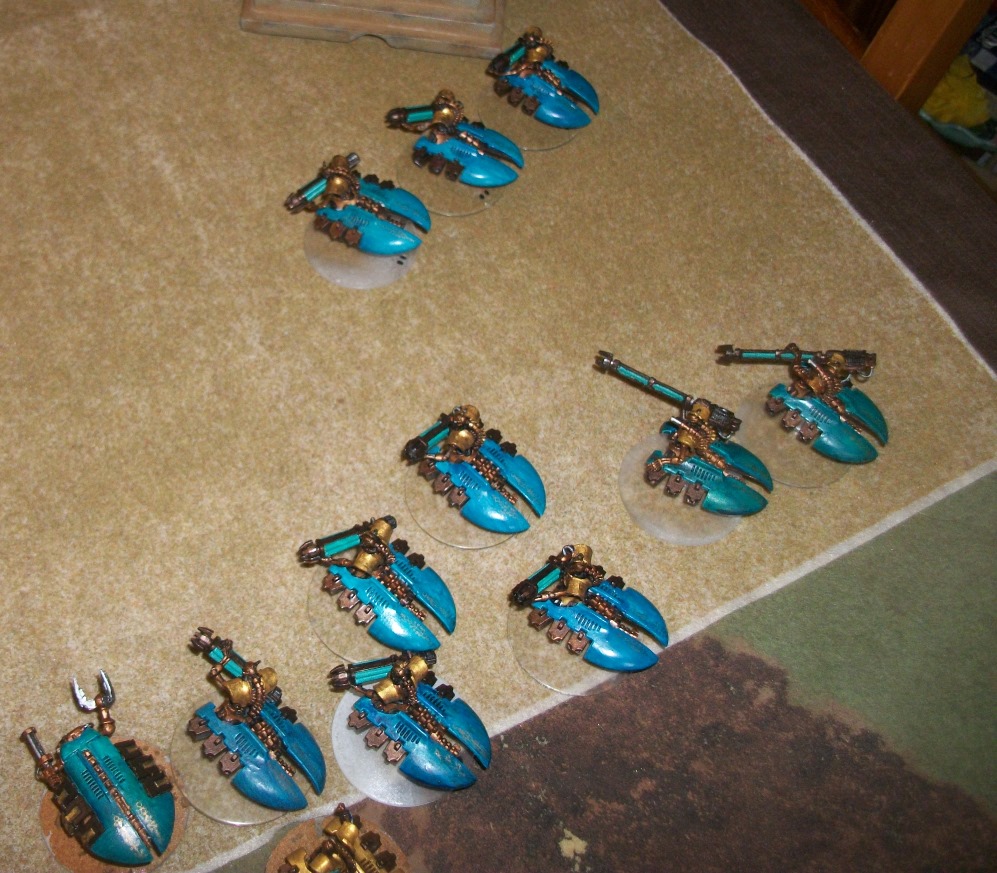
A third list is based around all seven of my Night Scythes (“Night Transports”) and Doom Scythes (“Doom Fighters”). It’s pretty hardcore, and I only use it against experienced players who want a challenge. It’s definitely not for newbies!
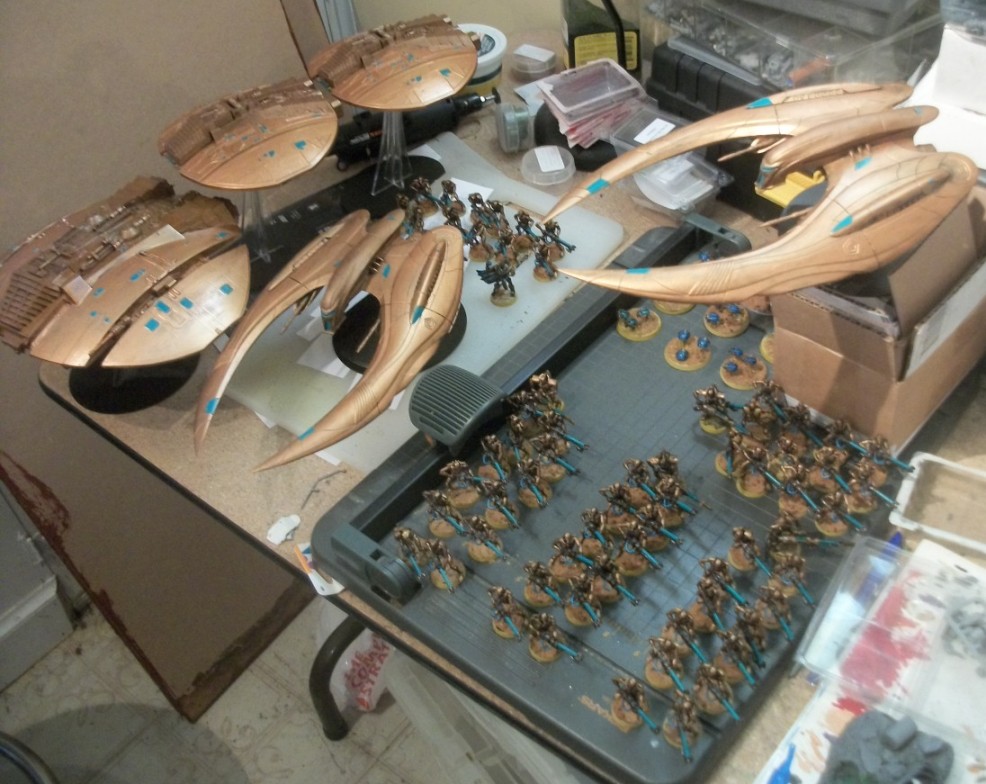
My army also has many Scarabs (the GF version are “Bot Swarms”) and some Canoptek Spyders (“Forge Spiders”) to counterattack enemies who get too close to my lines. As I mentioned, there are a few units that I used to have (Flayed Ones, a Monolith, and The Deceiver) which I got rid of, but I don’t intend to add any new units, as the army is plenty big already.
Conclusion
So, there you have it. My friend Pat assembled what I thought was a solid foundation, and after some extensive stealing—errm, “borrowing”—from an old TV show, I’ve come up with what I think is an interesting army. Hopefully, you agree. Even after owning this army for 20+ years, I’m still fond of it, and I hope to be playing it for many more!
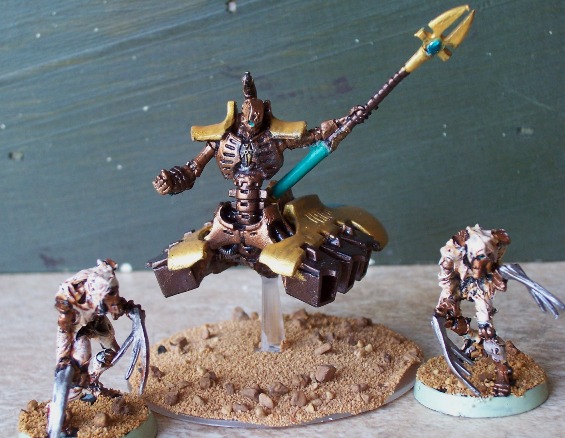
Kenton Kilgore writes killer SF/F for young adults and adults who are still young. The Fighting Tigers of Veda appear in his latest novel, Stray Cats, which you can find here.

Check him out on kentonkilgore.com, and follow Kenton on Facebook for frequent posts on sci-fi, fantasy, and other speculative fiction. You can also catch him on Instagram, and find his books in softcover and for Kindle on Amazon.
